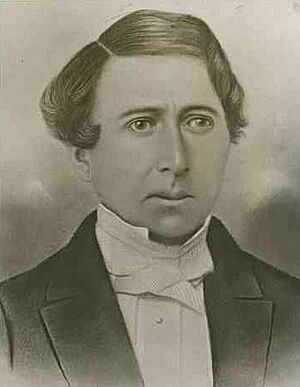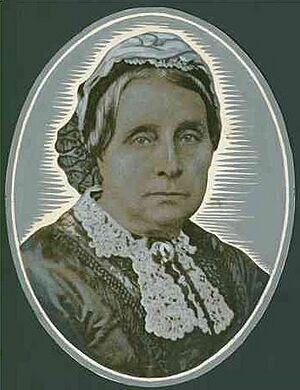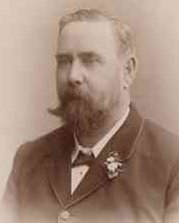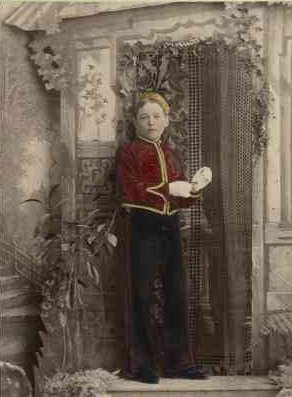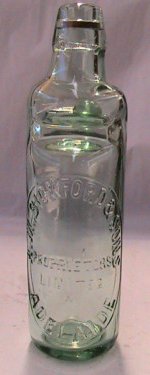History of Bickford's Australia facts for kids
| Industry | Pharmacist, pharmaceutical chemist |
|---|---|
| Founded | 1839 |
| Founder | William Bickford |
| Headquarters |
Adelaide, South Australia
|
|
Key people
|
William Bickford Ann Margaret Bickford |
| Partnership | |
| Industry | Pharmaceutical chemist, beverage manufacturer |
| Founded | 1864 |
| Founder | Ann Margaret Bickford |
| Headquarters |
Adelaide, South Australia
|
|
Key people
|
Ann Margaret Bickford William Bickford (jr.) Harry Bickford |
| Limited liability company | |
| Industry | Pharmaceutical chemist, beverage manufacturer |
| Founded | 1903 |
| Headquarters |
Adelaide, South Australia
|
| Limited liability company | |
| Industry | Beverage manufacturer |
| Founded | 1991 |
| Headquarters |
Salisbury South,
South Australia |
|
Key people
|
Angelo Kotses |
| Owner | Kotses family |
Bickford's Australia is a famous company known for its drinks. It started as A. M. Bickford and Sons, one of the first companies in South Australia to make chemicals and medicines. Until 1930, it was one of the state's most important family-owned businesses.
In 1930, Bickford's joined with several other Australian companies to form "Drug Houses of Australia" (DHA). DHA continued to make Bickford's products. They sold medicines and chemicals under the DHA name. The cordials and soft drinks kept the "A. M. Bickford and Sons" brand.
In the late 1960s, DHA faced financial problems. By the mid-1970s, the company struggled with a lot of debt and eventually broke apart. Different parts of the company were sold off. Reckitt & Colman bought the main medicine and chemical products. Peter Abbott, from Melbourne, bought the pharmacy products, eucalyptus oil operations, and the soft drink products. He later sold the pharmacy products. The eucalyptus oil business became part of "FGB". The soft drinks continued under the "A. M. Bickford and Sons" name.
In the late 1980s, FGB decided to focus on its main businesses. So, they sold the soft drink business and the well-known Bickford brand names. In 1999, the Kotses family bought the soft drink business and company names. "Bickford's" became a family-owned business in South Australia once again. Today, Bickford's Australia is still known for its wide range of cordials and flavorings. They are still made to a very high standard.
Template:TOC limit=3
Contents
How Bickford's Began (1839–1864)
William Bickford: The Founder
William Bickford (born 18 August 1815 – died 11 September 1850) was the seventh of fourteen children. His family in West Alvington, England, was well-off. However, when his father died, most of his money went to his oldest son from an earlier marriage. William and his siblings had to find their own way. At age fifteen, William began training to become a chemist.
In September 1838, when he was 23, William left England from Plymouth. He sailed around Africa and arrived in Port Adelaide on 15 February 1839. He had hoped to become a shepherd in South Australia. But soon after arriving, he worked as an assistant at a doctor's clinic. He earned £2 a week, plus food and a place to stay.
On 18 August 1839, his 24th birthday, he married Ann Margaret Garrett. They had met on the ship from Portsmouth. Their first child was born on 6 June 1840 but died soon after. Ann was very sick for a while. In March 1840, William wrote that his employers had left the colony. He found another job managing a shop and clinic for two surgeons. He earned £3 per week.
Even though the colony faced economic problems, William's business did well. He left his job at the clinic. By September 1840, he opened his own shop in Hindley Street. He borrowed £220 to start. His shop did well, and he soon moved to a bigger place at 67 Hindley Street. As his business grew, selling products to other businesses became the main part of his company.
In April 1841, he wrote that his business was doing well. He also said he had a comfortable home and a good wife who supported him. Ann was very helpful and could run the shop when William was away. Their first son, William, was born on 19 November 1841. Harry followed in February 1843, and Elizabeth in November 1844. In December 1845, they lost a baby. William decided to move his family out of the city due to unhealthy conditions. He bought 16 acres (6.4 ha) of land in Glen Osmond, South Australia, about 3 miles from the Adelaide city centre. In 1846, he built a house there called "Benacre". He moved his family before summer and traveled to his city business daily. They lost another baby in 1848, but Edward was born in 1849.
William cared about Adelaide's growth. In 1847, he helped start the South Australian Institute. Another founder was his business rival, Francis Faulding.
In February 1850, William wrote that he had planted fruit trees and vines in his garden. However, he did not live to enjoy them. He died on 11 September 1850, at age 35, from "brain fever" after a three-day illness. He left his wife, Ann, pregnant with Mary, and four young children (William, Harry, Elizabeth, and Edward).
Ann Margaret Bickford: Keeping the Business Alive
Ann Margaret Bickford (born 1810 – died 24 January 1877) was determined to continue her husband's business. With five children under ten, she got help from a retired pharmacist, Mr. Paxton. She soon hired qualified chemists, Edwin Page and Robert Hutton. With their help, she ran the business for 14 years. (Mr. Hutton later opened his own pharmacy in 1863.) On 29 May 1865, the shop moved again to 19 Hindley Street.
In early 1873, they opened a shop in Taylor Street, Kadina, South Australia. This shop was advertised until 1888.
Ann's death in 1877 was only briefly mentioned in newspapers. She was buried in a vault at West Terrace Cemetery with William Sr.
The Second Generation
William and Ann's children were:
- Unnamed child (born 6 June 1840)
- William Bickford (born 19 November 1841 – died 20 September 1916)
- Harry Bickford (born 24 February 1843 – died 6 September 1927)
- Elizabeth "Bessie" Bickford (born 29 November 1844)
- Eulelia Bickford (born 8 November 1846 – died 25 February 1847)
- James Bickford (born 19 February 1848 – died 29 February 1848)
- Edward Bickford (born 30 May 1849 – died 7 January 1907, in Brooklyn, New York, United States)
- Mary Bickford (born 25 April 1851 – died 12 December 1882, in Bournemouth, England)
The children received a good education. They studied at the Adelaide Educational Institution, a school run by J. L. Young. Harry was doing well there in 1853. Both he and Edward won prizes in 1855. Harry stayed connected to his old school, becoming president of the Old Scholars in 1866.
William, though not as focused on academics, was important. In 1863, he helped welcome back "old scholars" W. P. Auld, James Frew, and Stephen King. They were returning members of Stuart's sixth expedition, which had successfully crossed Australia.
William Bickford Jr. (1841–1916)
The older son, William Bickford (jr.) (born 19 November 1841 – died 20 September 1916), was less interested in school than Harry. He gained experience by traveling and taking various jobs.
In 1871, he married Margaret Jane Ferguson. They had seven children:
- William Ferguson Bickford "Willie" (born 30 November 1871 – died 22 June 1889) died at 17 in a riding accident.
- Sidney Bickford (born 10 August 1874 – died 10 December 1938) moved to Perth in 1895.
- Harold Bickford (born 16 May 1876 – died 23 October 1958) became Managing Director of A. M. Bickford & Sons Ltd from 1908 to 1930.
- Norman Forsyth Bickford (born 14 January 1877).
- Evelyn Victoria Bickford (later Mrs. Robert Ezekiel Reid) (born 7 June 1878).
- Reginald Bickford (born 26 January 1880 – died 20 November 1948).
- Leslie Bruce Bickford (born 30 December 1885).
Their first home was "Fairfield" in Somerton. Later, they lived at "Alvington" near Brighton Esplanade. Both William and Harry sent their sons to St. Peter's College, Adelaide. This became a family tradition.
William became a Justice of the Peace in 1886. He was also elected president of the Justices' Association from 1903 to 1904. He served on the Brighton council and was Mayor of Brighton from 1886–1887 and 1890–1891. He was president of the Adelaide Chamber of Commerce from 1894 to 1895.
In 1886, he and his brother Harry bought Burnside Station near Naracoorte, South Australia. They never lived there but hired a manager and visited often. The fine merino wool from the station always sold well. By 1900, they wanted to sell the property. The South Australian Government was not interested at their price. So, they divided the 40,978 acres into 28 lots and sold them at auction in 1908.
Harry Bickford (1843–1927)
Ann's son Harry Bickford (born 24 February 1843 – died 6 September 1927) was sent to England in 1859. He went there to become a qualified chemist and gain experience. He returned in 1863.
Harry was not very involved in public affairs. However, he loved horses. He was Master of the Adelaide Hounds from 1882. He was also on the committee of the South Australian Jockey Club from 1889. He was a very good shot and won important awards for pigeon shooting.
When the company became a public company in January 1903, Harry was chosen as the first managing director. He gave the job to his nephew Harold in 1906.
Harry was married three times. His first wife was Charlotte Jane Farr (died 4 September 1866). They had no children. He married Rosina Mary Ferguson (died 5 October 1898) in 1870. They had three children:
- (Isabella) May Bickford (born 12 April 1872 – died 28 July 1933) who never married.
- H(arry) Fairweather "H.F." Bickford (born 1874 – died 8 July 1906).
- Harding William Bickford (born 14 January 1877 – died 5 August 1919) who never married.
In 1904, Harry married Priscilla Simms (died 17 November 1924). They had no children.
The two brothers, William and Harry, also invested a lot in the "Paramatta" copper mine in Moonta in the late 1890s.
Bickford & Sons: Growth and Change (1864–1930)
Bickford & Son (1864–1871)
In 1863, Harry returned from England as a qualified chemist and started working for his mother, Ann. On his 21st birthday, Ann officially made him a partner in the business. The company was then called 'Bickford and Son'. On 23 February 1864, they signed an agreement for seven years. Ann owned two-thirds of the business, and Harry owned one-third.
A. M. Bickford & Sons (1871–1903)
William was not ready to settle down yet. He traveled around the state, working many different jobs. Seven years later, in 1871, he was ready to join the family business. A new agreement was made for the new partnership, 'A.M. Bickford and Sons'. William became the manager and helped promote the business.
Expanding into Wholesale
As the wholesale and manufacturing parts of the business grew, the retail shop was sold around 1870. Large offices and a warehouse were built at 42–46 Currie Street in 1879. This building remained the company's main office for many years.
In 1872, they built the South Australian Cordial Factory on Waymouth Street. Here, under Stephen Bickford (about whom little is known), they made various cordials. These included lime juice cordial, raspberry vinegar, and raspberry balm. They also produced peppermint, lemon, sarsaparilla, and other flavored drinks. Production started in 1874. Today, Bickford's Australia labels still show the Bickford's logo with "Since 1874." In 1876, the factory grew and became the South Australian Cordial and Aerated Water Factory. Mons. H. Foureur, who was French, managed the fizzy drinks production.
After their mother died in 1877, the two sons, William and Harry, continued and expanded the business. William kept in touch with important customers all over the state. He traveled along the Murray River as far as Wentworth, New South Wales and up the Darling River to Wilcannia. This three-month journey was done twice a year for several years. Harry managed the business in Hindley Street. He was the first President of the Pharmaceutical Association of S.A. He was also known as a sportsman and was Master of the Adelaide Hunt Club for many years.
Alvington Estate
Around 1880, as his business grew and his family got bigger, William built a large home called "Alvington." It was in New Glenelg (now Somerton Park, South Australia) on a property with beach access. It was named after West Alvington, his grandparents' home village. William Bickford did not live long to enjoy the grand house. When he died in 1918, he left his wife Margaret and son Harold with a large debt. However, they still lived a comfortable life with servants.
From 1938 to 1976, Alvington became "Somerton Home" for the Crippled Children's Association. This organization helped children with polio. In 1976, the children moved to a new facility. The property was then sold, and the building was taken down.
The Third Generation
Sidney Bickford (born 10 August 1874 – died 10 December 1938), William Jr.'s second son, opened the Perth branch.
Harold Bickford (1876–1958) took over from his father, William Jr., as managing director.
Harding William Bickford (born 14 January 1877 – died 5 August 1919), Harry's youngest son, was a well-known cyclist when he was young. After working in the company's labs for a few years, he went to London in 1898 to become a pharmacist. When he returned to Adelaide in 1903, he worked as an assistant lecturer at the University of Adelaide. Later, he managed A. M. Bickford & Sons' offices in Sydney and then Brisbane, where he died.
Reginald Bickford (born 26 January 1880 – died 20 November 1948), a younger son of William Jr., managed the Cordial and Aerated Waters factory for many years. He took over from Stephen Bickford, who was not a close family member.
Leslie Bruce Bickford (born 30 December 1885), William Jr.'s youngest son, became the manager of the Surgical and Veterinary Department.
Felton Grimwade & Bickford Ltd. (1902–1930)
In 1895, the company decided to expand west. They sent Sidney Bickford and Robert McClure to set up a Perth branch. They were directly competing with Felton Grimwade & Co. from Melbourne. After a few years, they decided to join forces.
In 1902, Felton Grimwade & Bickford Ltd. was started in Western Australia. It was a partnership between Felton Grimwade & Co. and A.M. Bickford & Sons. Robert McClure was their first managing director. Sidney Bickford married a girl from Perth and settled there, mostly breaking ties with the Adelaide family business.
A. M. Bickford & Sons Ltd (1903–1930)
In 1903, the company became a limited liability company called A. M. Bickford & Sons Ltd. This meant the owners' personal risk was limited.
In 1914, the manufacturing laboratory moved to Waymouth Street, next to the cordial factory. New facilities were added, including a large autoclave (a machine that sterilizes things with heat and pressure), a bonded warehouse (for storing goods before taxes are paid), and equipment to make pure alcohol.
In 1920, the dental supplies part of the business became a separate company. It was called Commonwealth Dental Supply Company Ltd. and had its main office in King William Street.
Bickford's Famous Products
In 1874, after the South Australian Cordial and Aerated Water Factory opened on Waymouth Street, the company started making high-quality cordials and fizzy drinks. Soon, these products, including the famous Bickford's Lime Cordial, won international awards for their excellent quality.
"Maltox" was a "health tonic" made from port wine with barley malt and beef extract added.
In 1920, Bickford's began making branded Coffee and Chicory Essence. This was later renamed Bickford's Iced Coffee Mix. It won a gold medal at the All-Australian Exhibition in 1930. These and other products are still made using the same original recipes today.
In 1922, Bickford's "Sal Vital" first went on sale. It was a fizzy "health salt" powder. The company said it "contains all the elements that tend to cool and purify the blood, and makes as well, a refreshing and cooling beverage."
Bickford's Today: The Kotses Family (1999–Present)
In 1999, the Kotses family bought the company.
In the early 2000s, iced teas and milkshake mixes were added to the range of products.
In 2005, the parts of the company related to cordials and soft drinks, now called "Bickford's Australia," moved to a new, modern factory in Salisbury, South Australia. Since moving to the new plant in 2005, the range of products has grown a lot.
In 2006, Bickford's lime juice cordial was recognized as a Heritage Icon by the National Trust of South Australia. In the 2010s, the range of products continues to expand. The Bickford's Group also includes other brands like Vok, Wheel & Barrow, and Karma Living.
In February 2014, Bickford's announced plans for a new distillery in the South Australian Riverland. An article stated that a key to Bickford's success has been buying brands that are not doing well and finding ways to make them popular again.
Images for kids


